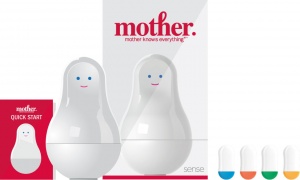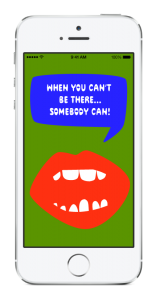Jumping the Physical Digital Divide
Posted September 8, 2014
There has been a lot of talk lately about the digital/physical divide, that space between a real-world and a digitally mediated experience. It is ever allusive and hard to define, but the problems it presents are central to designing for the future. The concept of the “Internet Of Things” attempts to span the gap between code and corporeal with devices that are digitally connected to our daily lives and habits. Retailers have built online/offline shopping experiences that allow customers to purchase what they want, when they want, and how they want. Even art projects deal with this realm more and more frequently. For example, the most recent Barbican exhibit featuring Google Dev supported makers.
Geoff Manaugh from Gizmodo recently went to PEPCOM and wrote about the connected thermostats, alarm systems, motion sensors, door locks, and much, much more that could make up the future digital home. These “intelligent” things are another stage in the evolution. These devices exist to connect us to the world around us, to facilitate action. In doing so, they clamor for attention. The devices and their makers try to convince us that their presence will make our lives better, more efficient, the coffee easier to make, or the door easier to open. The connected house is the wave of the future.
Manaugh presciently writes, “Like much poorer versions of Tony Stark—who, beneath all the rockets and gusto, spends most of his time home alone in a windowless room, talking to machines—we seem destined to replace our loved ones with interactive surrogates, and the automated, networked home is an early glimpse of what this might look and feel like.” He continues to describe a large selection of devices that respond to voice commands, “okay, thermostat”, “okay, refrigerator”, “okay, door”, and on and on.
Certainly, developing tools that simplify and make it more efficient to cool our homes is a positive improvement. What is still a struggle for producers and consumers alike, is engagement. And I don’t mean just interaction, but engagement, which is a reciprocal process that links entities in a mutually beneficial exchange. Are the tasks that connected devices perform simply reducing effort, or are they allowing us a deeper experience? Are they swinging at the lowest hanging fruit or tackling real problems of experience in our lives? Most of the time it is the former.
The better lock, lightbulb, thermostat, blender, motion sensor, and garage door opener are developed to replace the mundane acts in our day-to-day. But they don’t in turn open up new avenues for engagement in our lives. Is this a problem? Should the lock of the future be a key to satisfaction? Not necessarily, but we should hold the producers of the connected world to a higher standard than providing us with enhanced activities we already perform. The market will and has rewarded innovators. But to make the point more clear, let’s look at some makers and creators that are succeeding in reframing the conversation around tasks and acts we do regularly.
A couple of groundbreaking musicians have delved into the digital world to push the way we experience their music. When Bjork released her companion app to her album Biophilia, listeners got a taste for self-guided musical experiences. Their fingers steer the experience and make new graphics from their interactions, which drives the music. The app allows users to push deeper into the musical experience, react to vibrant visuals, and almost compose as the digital exploration developed.
More recently, Radiohead released an app call PolyFauna that is also a visual and musical experience. The band’s singer, Thom Yorke, created new sounds and commissioned graphics to compliment their last studio album, King Of Limbs. The app has a physical interactive component. A movement in space with your device, corresponds to the movement of the onscreen graphics and the sounds that accompany the eerie landscapes. There is a physicality in both Bjork’s and Radiohead’s app albums that entail many types of experiences. In themselves, albums are experiences, and the addition of the application and the ability to experience the work in new, different ways, increases engagement.
The obvious drawback and diversion from our discussion is the apps’ reliance upon a screen. They are self-guided, engaging, cross divides between passive and active experiences, but not the entire digital/physical divide. Yet they do set the stage for the type of digital/physical experiences that create deeper engagement with audiences.
Another app takes this a step further, utilizing the digital sphere to change experiences in people’s lives. Miranda July — writer, director, and actress — released an app driven messenger service called Somebody. On the surface there is nothing new here. An app that connects people to deliver a message. But the premise behind the app is original, and might have only been developed by an artist supported by a luxury fashion label. (Miu Miu, the Prada cousin, supported the development of the app and made the short film that showcases how the technology works.)
The app functions as a volunteer service provider. Users either request a message be delivered for them or they can deliver a message on behalf of someone else. The app uses geo-location to connect the two parties, plotting where you are in relation to the recipient. In theory, your mother could send you a kind word via another Somebody user in your vicinity. Messages could be delivered in a friendly tone, uncomfortable messages could be mediated by a stranger, and awkward relationships could start from a bizarre request. This app makes the leap from digitally mediated experience to creating a new experience through a digital platform. Like a dating app, the medium is not the end, but a means to continuation.
We certainly don’t want our thermostats and kitchenware connecting us with strangers like the Somebody app. The problems inherent in autonomous devices have been well explored in movies and dystopian fiction. So using your doorbell to create person-to-person experiences is most likely not going to happen. The real point, for people, brands, and institutions, is that no matter what you create, the goal is the same — a true experience, an emotional engagement.
The maker of Mother didn’t design their product to look like a mix between a duck, Russian dolls, and cartoon characters because they thought it would make it easier to find in the cabinet. They counted on our desire to be connected, whether to technology or those others, those people.

We now exist in a present that is mediated by digital means of communication and supported by “intelligent” devices. We are told that our refrigerators will soon communicate with our phones, our phones with our houses, and our interests and preferences will be mapped to our lives. It is a brave new world that could lead to more satisfaction, more ease, and greater efficiency.
But as Geoff Manaugh cautioned above, these devices are mere surrogates for the tips of our fingers and facilitators of our voices. Most of these objects don’t create new experiences, they augment pre-existing acts, expanding our reach in time and space. The bridge between the physical and digital requires the addition of engagement. The value of the blend between the two realms relies upon new meaning and the creation of new experiences that connect users.
As we move forward, designers will be tasked with remembering this important detail. The user is the center of the experience, whether that is opening a door, meeting someone new, or connecting with a loved one. The design should start with that audience behavior. If design does not respond, we will have homes and lives filled with automated tasks, but no engaged acts. And despite the plethora of expensive gadgets that we will surround ourselves with, we will be poorer for it.



Join The Conversation